Apple's 2010 MacBook Air (11 & 13 inch) Thoroughly Reviewed
by Anand Lal Shimpi on October 26, 2010 10:08 PM EST- Posted in
- Mac
- Apple
- MacBook Air
- Laptops
The 11-inch MacBook Air: Faster than the old 13-inch MacBook Air
On paper, the new 13-inch MacBook Air shouldn’t be any faster than the old 2008 MacBook Air - at least in CPU bound tasks. The 2010 model gets a faster GPU but the CPU is literally the same 1.86GHz Core 2 Duo. Memory sizes and speeds haven’t changed either. While the SSD is faster, if you’re running a CPU bound benchmark there shouldn’t be any performance difference. If you assumed the same thing I did, you’d be very wrong.
Take a look at Cinebench 11 comparing the 2008 13-inch MacBook Air to the two 2010 models:
| Cinebench 11 - Multithreaded CPU Benchmark | |||||
| 11-inch MacBook Air (2010) - 1.4GHz Core 2 Duo | 13-inch MacBook Air (2010) - 1.86GHz Core 2 Duo | 13-inch MacBook Air (2008) - 1.86GHz Core 2 Duo | |||
| Cinebench 11 Score (Higher is Better) | 0.81 | 1.1 | 0.70 | ||
Not only is the 2008 13-inch MBA slower than the new 13-inch model, it’s actually slower than the 11-inch model running at 1.4GHz. Something is amiss. Perhaps it’s just this benchmark?
I turned to our Handbrake H.264 encode test to verify my sanity:
| Handbrake 0.94 - H.264 High Profile Transcode | |||||
| 11-inch MacBook Air (2010) - 1.4GHz Core 2 Duo | 13-inch MacBook Air (2010) - 1.86GHz Core 2 Duo | 13-inch MacBook Air (2008) - 1.86GHz Core 2 Duo | |||
| Average Frames per Second (Higher is Better) | 1.14 fps | 1.55 fps | 0.96 fps | ||
Once again, a similar situation. The old MBA is actually slower than the new 11-inch, despite the advantage in CPU speed.
It looks like what we’ve stumbled upon is a combination of Apple aggressively throttling the clock speed of the older MacBook Air CPUs to meet thermal requirements, and the CPUs used in the new MacBook Airs being far better behaved from a voltage/power consumption standpoint.
The 45nm process these Core 2s are built on is as mature as it’s going to get. I’m guessing yield on these parts is as high as can be and as a result, power consumption is probably consistently lower than the original 1.86GHz parts Apple shipped back in 2008. The peak thermal specs themselves haven’t changed, but the actual power characteristics have.
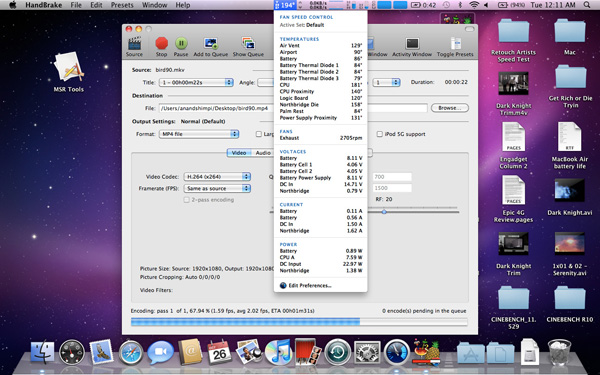
The 2008 MacBook Air under Load
Maximum temperature, at least reported by the MBA’s sensors, isn’t any lower on the new 13-inch than the 2008 I compared it to. Both CPUs hit roughly 84C (183F) under full load. But look at what happens to the chips after a minute at that load:
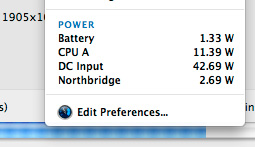 2010 13-inch MacBook Air |
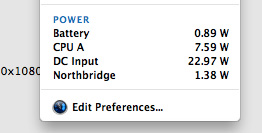 2008 13-inch MacBook Air |
iStat Menus reports the 1.86GHz Core 2 Duo in the 2008 system consuming only 7.59W, while the same CPU in the 2010 machine is drawing 11.45W. The 2008 machine is throttling back to reduce overall temperature while the 2010 system keeps going.
As a result, even the 11-inch MacBook Air will probably end up being as fast, if not faster than the 2nd generation 2008 13-inch MacBook Air. And our performance results confirm that:
| 11-inch MacBook Air (2010) vs. 13-inch MacBook Air (2008) | ||||||||
| Application Launch Test | Adobe Photoshop CS4 | Aperture RAW Import | Cinebench R10 - 1CPU | Cinebench R10 - XCPU | Quicktime H.264 Transcode | |||
| Apple 11-inch MacBook Air (2010) - 1.4GHz Core 2 Duo | 27.8 seconds | 72.4 seconds | 1.29 PPS | 1612 | 2967 | 33.1 fps | ||
| Apple 13-inch MacBook Air (2008) - 1.86GHz Core 2 Duo | 26.4 seconds | 71.3 seconds | 1.20 PPS | 2046 | 2882 | 30.1 fps | ||
You'll notice the less CPU intensive tasks are quicker on the old 13-inch system as the CPU isn't able to get hot enough to trigger Apple's throttling. The single threaded Cinebench test is the best example of this. The 26% performance advantage jibes with the 33% increase in CPU clock speed (it's actually a little low, most likely because the old CPU still isn't running at full speed even in this test). But now look at the heavier tests - the multithreaded Cinebench test and the Quicktime encode. Both of these stress both cores and drive TDP up, which forces Apple to pull clock speed back down. We wondered how Apple was able to cram such a high speed CPU into such a thin chassis as early as it did, now we know.
In practice I found the 2008 13-inch MBA launched applications quicker (short bursts of full clock speed), but after prolonged use or completing CPU intensive tasks it was tough to tell apart from the new 11-inch. What's even more troublesome is that Apple's aggressive clock throttling went relatively undetected until now. This is something I'm going to have to devise tests for and pay more attention to in future reviews. Sneaky, Steve, sneaky.
External Temperatures and Noise
The old MacBook Air chassis had a few dozen slits cut out of the aluminum for ventilation. The new MacBook Air chassis hides the ventilation slits between the base of the unit and the hinge. You can’t see them, but they’re there.
The slits are smaller than they were on the old chassis, which means moving air through them at the same rate sounds louder than before.
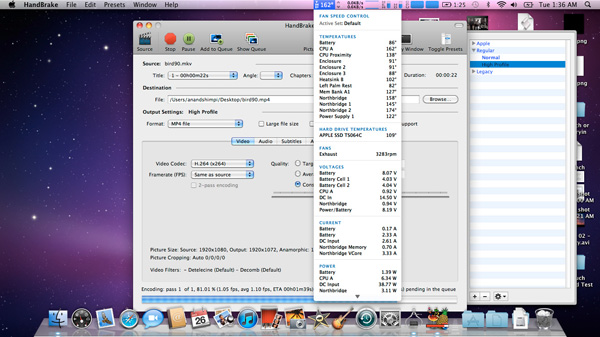
The 11-inch MacBook Air under Load
The CPU in the 11-inch model, even when under heavy loads, likes to stay at or below 72C (162F). At that temperature, the internal fan doesn’t spin above 4000 RPM (usually down below 3400). The 13-inch MacBook Air however is far more likely to generate noise. Running our simple Handbrake test the CPU will peak at over 82C (~180F) and the system’s internal fan will ramp up to over 6K RPM to compensate. Not only does the chassis get hot, but the fan gets audible. It’s still too small of a fan to really be considered loud in the grand scheme of things, but it’s loud enough to be annoying.
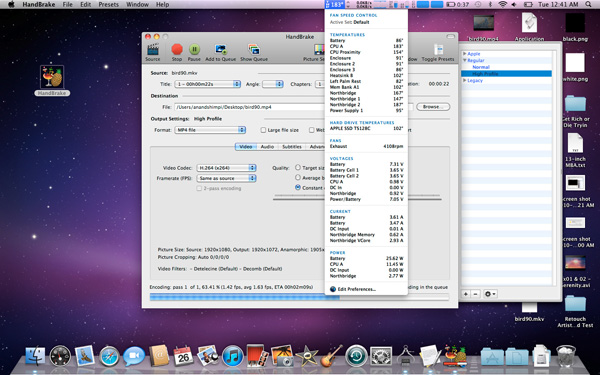
The 13-inch Macbook Air under Load
The surface temperature of the new 13-inch MacBook Air easily gets as high as the 2008 model. I measured a peak of 38.9C (102F) on both the 2008 and 2010 13-inch models. The 11-inch never broke 38C (100F).
Even casual use can ramp up temperatures pretty quickly. Just having a few websites open in the background that use Flash or other CPU intensive elements can slowly cause the MBA’s internal temperatures to rise. And now you’re beginning to see why Apple doesn’t install Flash on these things by default.
The danger zone is the upper left corner of the system, near the hinge. There’s only a single fan that cools both the CPU and GPU in the Air’s very tight enclosure. This is where that fan sits.










185 Comments
View All Comments
cabjf - Tuesday, October 26, 2010 - link
The fact that the iPad will easily sync with your main computer does give it one advantage over the Air. If Apple produced some type of easy to use syncing software so that you could use the Air as a portable version of your main computer's contents, it would be the perfect road companion to an iMac, Mac Pro, or even a 17-inch Macbook Pro. Perhaps that is the way they are moving in bringing an App Store and other iOS features to Mac OS X. Maybe that's part of the intended use for that huge data center they are building (and already considering expanding).wintermute000 - Wednesday, October 27, 2010 - link
" If Apple produced some type of easy to use syncing software so that you could use the Air as a portable version of your main computer's contents, it would be the perfect road companion to an iMac, Mac Pro, or even a 17-inch Macbook Pro."Easily done with a bit of work
- know where the files are and don't do things like let itunes sort folders
- rsync or any decent gui backup/sync software
storage is an issue but for work purposes 64Gb is enough to handle it
for streaming media use streaming media solutions.
psonice - Wednesday, October 27, 2010 - link
Apple sell 'mobile me' which pretty much does this. It gives you an 'iDisk' in the cloud, accessible from any of your machines (think it supports windows too?), plus there's an iphone app to access it. It also syncs your bookmarks, preferences, dock icons (don't think it syncs the actual apps though) and keychain (for passwords). There's push email + web hosting (main thing I use it for) and other bits too.It's $60/year, and it's possible to get pretty much everything for free elsewhere. But like a log of apple stuff, it works well, it's nicely integrated, and if you have the money it's not worth arsing around with the others.
Tmoz - Wednesday, October 27, 2010 - link
You could use Dropbox to do this: http://db.tt/eiXQTsi (Disclosure: Referral link)It syncs your files to Amazon S3 and then to any computers you have the software installed on (Mac/Windows/Linux are supported)
dendysutrisna - Friday, August 12, 2011 - link
Yes I understand, since this article was made when Apple's MacBook Air which has been reinforced Intel Core i5 has not come out. MacBook Air the latest generation, which has been paired with Mac OS X Lion, there is a AirDrop feature, where you can share with computer around you which in one network, even with the computer windows though. Try to look http://www.bestdealscomputers.net/netbooks/apple-m... I've made a little review about the newest MacBook Air, you might want to find out more.quiksilvr - Tuesday, October 26, 2010 - link
Seriously, their pricing scheme makes absolutely no sense. I have attempted to see what COULD be the decent price point, but a few points have to be made:1) The Macbook 13 (the white one) simply needs to die.
2) They are now hitting 4 different screen sizes, and IMO they should stick to three and make things easier (as should other PC makers)
1) 12" screen (not 11.6", 12") for the netbook market
2) 14" screen for the general market
3) 16" screen for the heavy multimedia and desktop replacement market
3) Get rid of the "Pro" terminology. Simply have it Macbook 12, 14, 16 and Air versions of these models (Macbook Air 12, etc.)
4) STOP forcing customers to get the "upgraded" version just so that we can upgrade the CPU. This is annoying and very Dell like and customers don't like it.
martyrant - Tuesday, October 26, 2010 - link
Apple has needed a price overhaul since the company's inception.Glad you are only now realizing.
darwinosx - Tuesday, November 2, 2010 - link
You are just too dumb to understand that similar quality, service, and a modern OS from other companies is as much or more than Apple products. Except they don't have a modern OS.quiksilvr - Tuesday, October 26, 2010 - link
Okay, here is my attempt (and I know this will never happen because it makes too much sense)Macbook Air 12: $799
Macbook 12: $599
Macbook Air 14: $999
Macbook 14: $799
Macbook Air 16: $1199
Macbook 16: $999
And as shocking as this may seem to Mac users, this is still a major premium over PCs.
Macbook Air Baseline:
-Core i3 LV (or ULV) with Core i5/i7 LV/ULV option (add thickness if necessary)
-Integrated Intel HD chip and dedicated nVidia card with Optimus
-SSD (I would say start it at 90GB and work your way up)
-USB 3.0 all the way
-mini Displayport with choice of adaptor included (DVI, VGA, HDMI, Displayport, etc.)
-Wireless, Bluetooth, yada yada
-4 GB RAM
-No Optical
-And one thing I just noticed, put an actual microphone PORT and put a stereo microphone next to the webcam
-Expresscard Slot option
Macbook Baseline:
-Core i3 with Core i5/i7 option (add thickness if necessary)
-Integrated Intel HD chip and dedicated nVidia card with Optimus
-HDD with SSD option (start HDD with 250GB)
-USB 3.0
-mini Displayport with choice of adaptor included (DVI, VGA, HDMI, Displayport, etc.)
-Wireless, Bluetooth, yada yada
-4 GB RAM
-DVD Burner with Blu Ray Player/Blu Ray Burner option
-Expresscard Slot option
5) And for the love of god, stop making these screens epic glossy. This is a message to ALL PC makers! Make it half and half or give a realistically priced matte option (FREE)
solipsism - Tuesday, October 26, 2010 - link
Nothing you wrote makes sense.How much is the ULV CPU from Intel?
How much is the LV CPu from Intel?
How much is that Nvidia 320M?
How much does it cost to mill an aluminum case?
How much are 9.5mm ultra-slim slot-loading BRDs?
Can you find any for sale?
Which Core-i3 LV and ULV chips will they use?
Which USB3.0 controller will they use, how much will cost, where will go in the Airs?
Where will this ExpressCard slot go?
Why scrape the 11, 13 and 15” Mac notebooks for 12, 14 and 16” displays?
Why didn’t you fail to address the size, weight, or quality of anything? You just took a price that you compared to other vendors, bumped it slightly and then added a whole mess of features without considering engineering, costs, or anything else. You might as well add include TARDIS technology to fit all that in there and/or use a TARDIS to go into the future to a time when all that is actually possible, but instead you just sound like a TARD in your self proclaimed “makes too much sense” post.